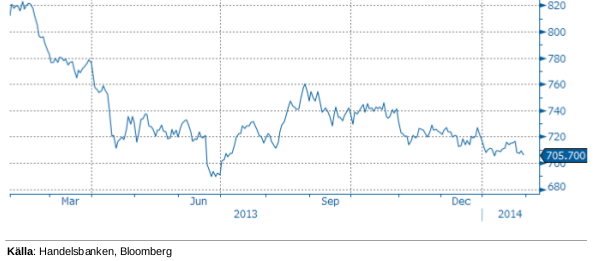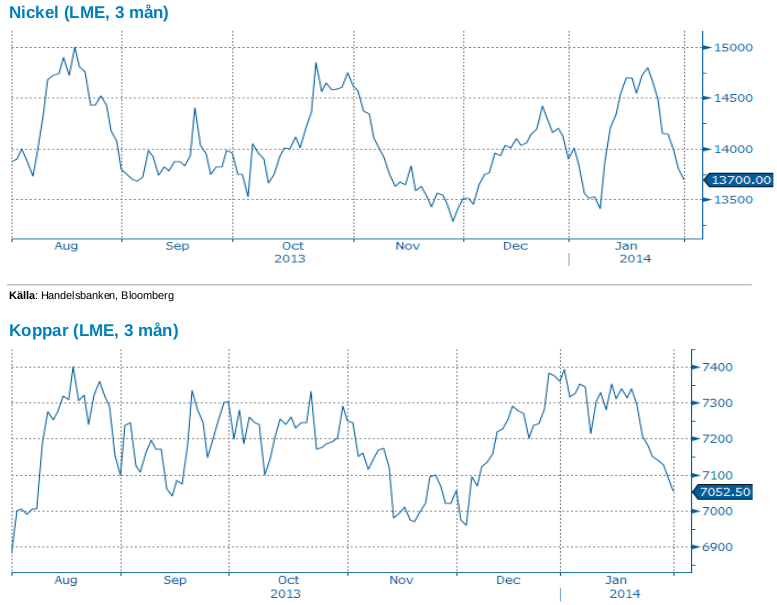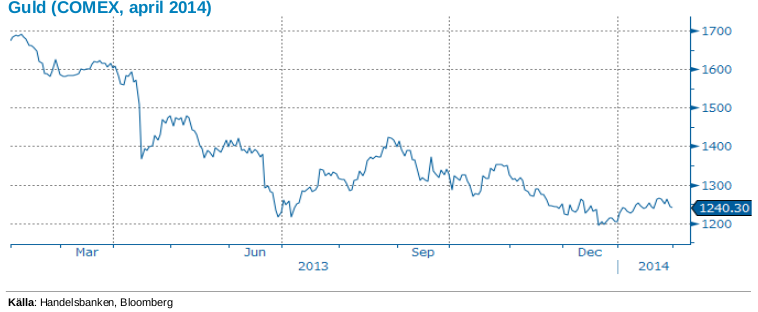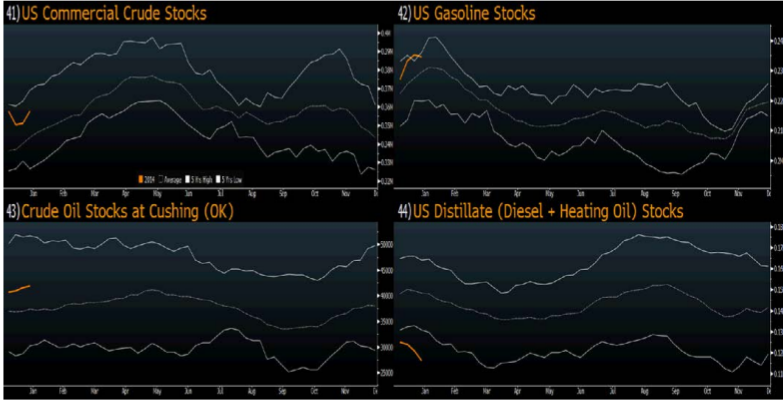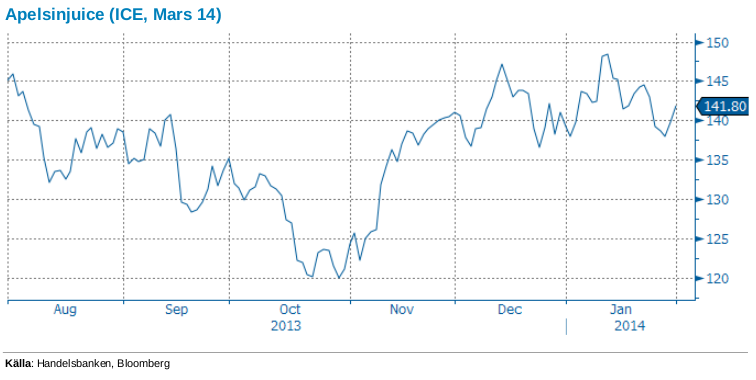Analys
SHB Råvarubrevet 31 januari 2014

 Råvaror allmänt:
Råvaror allmänt:
Globalt: sänkta tillväxtutsikter i EM på tapeten
 Emerging markets-oron har intensifierats trots att förväntningarna på Fed-höjningar har dämpats. Detta förklaras av att drivkraften utgörs av sänkta ekonomiska tillväxtutsikter. I den mån krisen intensifieras i större länder riskerar det att få påtagliga konsekvenser för både konjunktur och räntemarknad.
Emerging markets-oron har intensifierats trots att förväntningarna på Fed-höjningar har dämpats. Detta förklaras av att drivkraften utgörs av sänkta ekonomiska tillväxtutsikter. I den mån krisen intensifieras i större länder riskerar det att få påtagliga konsekvenser för både konjunktur och räntemarknad.
Kina utgör elefanten i rummet. Det mullrar från dess kreditsystem och risken för baksmälla är överhängande. Om marknaden sänker sina tillväxtförväntningar för Kina spiller det över till sämre utsikter även för USA och Europa. Sedan vår Kinaresa i september har vi argumenterat för att landet stod inför en kortvarig uppgång driven av stimulanser för att klara fjolårets tillväxtmål. Därefter oroades vi av de eskalerande dåliga lånen utan säkerheter. Dessa har nu börjat blomma ut och vi är rädda för att denna våg bara har startat.
Förväntningarna på Fed-höjningar har dämpats men förändrar inte utsikterna för Feds nedskalning av QE. Vi hävdar att det inte finns argument för Fed att skala tillbaka fortare än vad man aviserat med” hela handen”. Högst på Feds agenda just nu måste vara att undvika ”QE4”. Därmed är hela QE effekten inprisad i guld och just när konsensus äntligen blivit negativa till guld så byter vi fot från en mycket lyckad sälj till en köp. Utöver Fed så tror vi också att EM valutaoron och Kina kreditkrisen kan öka behovet av guld som säker hamn igen.
Handelsbankens råvaruindex (USD)
Basmetaller: Hästens år tar sin början
Så här första dagen på det nya kinesiska året kan vi konstatera att ormens år (2013) slutade som bekant i moll för metallerna. Det återstår att se vad Hästens år (2014) har att erbjuda men initialt ser vi få positiva signaler. Tillsammans med att lagercykeln i Kina står inför en vändning och det faktum att investerare blivit positiva till basmetaller under de senaste månaderna då lagren fallit gör att vi växlar från positiv till neutral syn på basmetaller. Säsongsmönstret för basmetaller har varit starkt de senaste åren med årstoppen i början av året följt av ett kraftigt fall fram till midsommar.
Under veckan har basmetallerna fallit på bred front där nickel sticker ut med en nedgång på dryga 5 %. Veckans PMI flash från Kina för januari kom in lägre än väntat och nattens officiella siffra väntas vara lägre än föregående månad, 50,5 mot 51 i december. Nästkommande vecka har Kina nyårsledigt och efterfrågan från de fysiska handlarna uteblir vilket kan göra marknaden mer känslig då omsättningen faller.
Låga prisnivåer, exportstopp av oförädlad nickelmalm från Indonesien och det faktum att 40 % av gruvorna går med förlust på dagens prisnivå. Vi tror på: LONG NICKEL H
Ädelmetaller: Dags för guldrekyl?
Vår långsiktigt negativa vy på guldet blev som bekant väldigt korrekt under 2013, då guldet noterade sitt näst värsta år i modern historia. När vi började argumentera för att guldet borde falla – då upptrenden av olika anledningar hade sett sitt slut – var vi ganska ensamma om vår negativa syn. Detta är, sannolikt, en av anledningarna till att fallet blev så dramatiskt och djupt. Att vara s.k. contarian och få rätt brukar vara en synnerligen framgångsrik strategi, problemet är bara att man sällan vet hur ”motvalls” man egentligen är, inte heller om man får rätt…
När vi nu kliver raskt in i 2014 ser det ut som att väldigt många har bytt fot, och att konsensus nu är negativt på guldet. Det är inte alls ovanligt att extrapolera historiken, och använda förklaringar till historien som argument för framtiden, och att trenden ska fortsätta. Nästan alla är bullish på all-time highs, det må vara aktier, bostadsrätter, tulpanlökar eller guld. När en tillgång sedan fallit under lång tid tror man att det aldrig kan vända upp igen – det går ju nedåt…
Men allt vänder, väldigt många marknader (i synnerhet råvarumarknaden) är s.k mean reverting, dvs de tenderar att röra sig kring en underliggande trend, varför det sällan är lönsamt att konstant försöka följa trenden.
Vi börjar därför hissa flagg för en rekyl uppåt i guldet. Det kommer att vara svårt med timing, triggers osv, men vi finner stöd för vår vy redan nu i ett par huvudpunkter.
- Vi upplever att majoriteten nu blivit negativa, varför en ”contrarian-strategi” kan vara lönsam
- Feds tapering har inte satt några märkbara avtryck i guldpriset ännu
- Utflödena ur ETF:er ser ut att ha avstannat (frågan är bara om det är tillfälligt). De senaste veckorna har t o m sett nettoinflöden.
- Den uppseglande emerging-marketsoron verkar inte ha avstannat trots veckans insatser från en rad centralbanker. Detta kan skapa en köpvåg i guld som skydd mot en eventuell emerging-kris.
- Indien som så överraskande minskade sitt inköp under 2013 till följd av höjda importavgifter och en svag valuta förväntas tillsammans med Kina svälja en allt större del av det guld som kommer ut på marknaden.
Efter en lång tid av negativ vy för guldet byter vi nu fot och tror på stigande pris. Vi tror på: LONG GULD H
Energi: Backloading ger utsläppsrätterna stöd
Elmarknaden backar 9 procent under veckan och är tillbaka på de låga nivåer vi såg i början av året. Samtliga faktorer förutom utsläppsrätterna verkar för nedsidan där en återgång till det milda och våta vädret är främst drivande. Senaste prognoserna visar på plusgrader i slutet av perioden samtidigt som uppemot 6 TWh nederbörd väntas, ca 3 TWh normalt vilket i så fall stärker energibalansen ytterligare.
Med ett sådant väder där spotpriser kommer in under förväntan och ett bränslekomplex som trendar nedåt (även om kolet funnit stöd på de lite lägre nivåerna sedan sommaren) blir det svårt för den korta kurvan att stiga. Det enda som ger ett visst stöd är utsläppsrätterna som stigit över 20 procent de senaste 2 veckorna efter att kommissionen nu driver på en snabbare process kring en eventuell backloading (dra bort 400 miljoner rätter) och en stabilitetsmekanism.
Oljemarknaden faller tillbaka något inför Kinas inköpssiffror och en förnyad oro kring den faktiska tillväxten i efterfrågan på oljeprodukter. Det är för närvarande svårt att se vad som skall driva marknaden genom denna rangehandlade nivå på Brent där uppsidan begränsas av en förbättrad balans men där den geopolitiska oron kring Syrien, Iran och Libyen alltid ger stöd på lägre nivåer. De flesta hade ju exempelvis räknat med att Libyen successivt trappar upp sin produktion, kanske inte till tidigare höga nivåer om ca 1.5 miljoner fat per dag men närmare hälften i bästa fall och tyvärr skapar situationen kring blockaden av landets tre oljehamnar fortsatt en stor osäkerhet. I övrigt så var de kommersiella oljelagren i USA som var veckans överraskning, de steg med 6.42 miljoner (se bild nedan över till vänster) vilket var den största rörelsen på 3 månader. Vi står därmed fast vid vår tro att det är svårt att vara annat än neutral till oljan men att den alltid är köpvärd ned mot dagens nivåer kring 106 dollar men där man inte bör räkna med så mycket högre oljepris än 110-111 dollar
Sammanfattningsvis håller vi en neutral vy för energisektorn.
Vi tror att det kommer ges möjligheter till god avkastning i denna range-baserade handel där oljan är köpvärd var gång den kommer ned lägre nivåer. Vi tror på: LONG OLJA H
Livsmedel: Citrussjukdom härjar i Florida
Citrussjukdom och frost i den amerikanska delstaten Florida, en av världens största producenter av citrusfrukter har gett stöd till terminspriserna på apelsinjuice de senaste månaderna. Sjukdomen som kallas för Citrus Greening saknar botemedel och ökad spridning är förödande för apelsinodlingen. I veckan har dock mildare väderförhållanden i regionen pressat ned priset. Vi ser allvarligt på bakteriesjukdomen och tror på stigande pris på apelsinjuice.
Priset på sojabönor har gått ned något under veckan, påverkat av inte minst bra väder i Sydamerika – i Argentina har det kommit mer regn vilket grödan gynnas av och i Brasilien har det blivit torrare vilket gynnar skörden. Omkring 8 procent av den brasilianska skörden uppges nu vara avklarad och avkastningen är hög. Tiden för eventuella problem innan skörden är avklarad i Sydamerika blir alltmer begränsad och det är svårt att se en uppsida för sojapriserna den närmsta tiden. Efter hand som utbudet ökar i Sydamerika och konkurrensen på exportmarknaden ökar tror vi snarare på en nedgång.
Vi ser allvarligt på bakteriesjukdomen som härjar i Florida och ökad spridning hotar att slå ut apelsinträden i år framöver. Vi tror på: BULL APELS X2 H
Handelsbankens råvaruindex
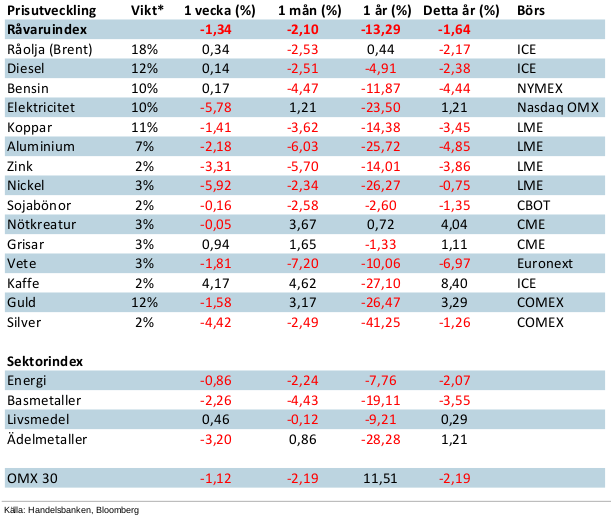
*Uppdaterade vikter från 29 november 2013
Handelsbankens råvaruindex består av de underliggande indexen för respektive råvara. Vikterna är bestämda till hälften från värdet av nordisk produktion (globala produktionen för sektorindex) och till hälften från likviditeten i terminskontrakten.
[box]SHB Råvarubrevet är producerat av Handelsbanken och publiceras i samarbete och med tillstånd på Råvarumarknaden.se[/box]
Ansvarsbegränsning
Detta material är producerat av Svenska Handelsbanken AB (publ) i fortsättningen kallad Handelsbanken. De som arbetar med innehållet är inte analytiker och materialet är inte oberoende investeringsanalys. Innehållet är uteslutande avsett för kunder i Sverige. Syftet är att ge en allmän information till Handelsbankens kunder och utgör inte ett personligt investeringsråd eller en personlig rekommendation. Informationen ska inte ensamt utgöra underlag för investeringsbeslut. Kunder bör inhämta råd från sina rådgivare och basera sina investeringsbeslut utifrån egen erfarenhet.
Informationen i materialet kan ändras och också avvika från de åsikter som uttrycks i oberoende investeringsanalyser från Handelsbanken. Informationen grundar sig på allmänt tillgänglig information och är hämtad från källor som bedöms som tillförlitliga, men riktigheten kan inte garanteras och informationen kan vara ofullständig eller nedkortad. Ingen del av förslaget får reproduceras eller distribueras till någon annan person utan att Handelsbanken dessförinnan lämnat sitt skriftliga medgivande. Handelsbanken ansvarar inte för att materialet används på ett sätt som strider mot förbudet mot vidarebefordran eller offentliggörs i strid med bankens regler.
Analys
Crude stocks fall again – diesel tightness persists

U.S. commercial crude inventories posted another draw last week, falling by 2.4 million barrels to 418.3 million barrels, according to the latest DOE report. Inventories are now 6% below the five-year seasonal average, underlining a persistently tight supply picture as we move into the post-peak demand season.

While the draw was smaller than last week’s 6 million barrel decline, the trend remains consistent with seasonal patterns. Current inventories are still well below the 2015–2022 average of around 449 million barrels.
Gasoline inventories dropped by 1.2 million barrels and are now close to the five-year average. The breakdown showed a modest increase in finished gasoline offset by a decline in blending components – hinting at steady end-user demand.
Diesel inventories saw yet another sharp move, falling by 1.8 million barrels. Stocks are now 15% below the five-year average, pointing to sustained tightness in middle distillates. In fact, diesel remains the most undersupplied segment, with current inventory levels at the very low end of the historical range (see page 3 attached).
Total commercial petroleum inventories – including crude and products but excluding the SPR – fell by 4.4 million barrels on the week, bringing total inventories to approximately 1,259 million barrels. Despite rising refinery utilization at 94.6%, the broader inventory complex remains structurally tight.
On the demand side, the DOE’s ‘products supplied’ metric – a proxy for implied consumption – stayed strong. Total product demand averaged 21.2 million barrels per day over the last four weeks, up 2.5% YoY. Diesel and jet fuel were the standouts, up 7.7% and 1.7%, respectively, while gasoline demand softened slightly, down 1.1% YoY. The figures reflect a still-solid late-summer demand environment, particularly in industrial and freight-related sectors.

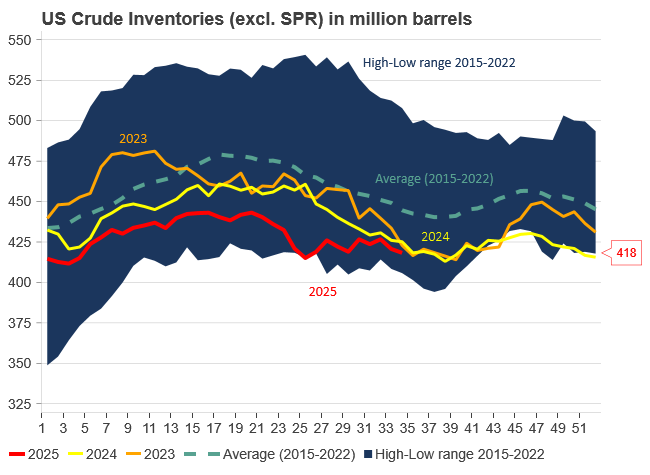
Analys
Increasing risk that OPEC+ will unwind the last 1.65 mb/d of cuts when they meet on 7 September

Pushed higher by falling US inventories and positive Jackson Hall signals. Brent crude traded up 2.9% last week to a close of $67.73/b. It traded between $65.3/b and $68.0/b with the low early in the week and the high on Friday. US oil inventory draws together with positive signals from Powel at Jackson Hall signaling that rate cuts are highly likely helped to drive both oil and equities higher.

Ticking higher for a fourth day in a row. Bank holiday in the UK calls for muted European session. Brent crude is inching 0.2% higher this morning to $67.9/b which if it holds will be the fourth trading day in a row with gains. Price action in the European session will likely be quite muted due to bank holiday in the UK today.
OPEC+ is lifting production but we keep waiting for the surplus to show up. The rapid unwinding of voluntary cuts by OPEC+ has placed the market in a waiting position. Waiting for the surplus to emerge and materialize. Waiting for OECD stocks to rise rapidly and visibly. Waiting for US crude and product stocks to rise. Waiting for crude oil forward curves to bend into proper contango. Waiting for increasing supply of medium sour crude from OPEC+ to push sour cracks lower and to push Mid-East sour crudes to increasing discounts to light sweet Brent crude. In anticipation of this the market has traded Brent and WTI crude benchmarks up to $10/b lower than what solely looking at present OECD inventories, US inventories and front-end backwardation would have warranted.
Quite a few pockets of strength. Dubai sour crude is trading at a premium to Brent crude! The front-end of the crude oil curves are still in backwardation. High sulfur fuel oil in ARA has weakened from parity with Brent crude in May, but is still only trading at a discount of $5.6/b to Brent versus a more normal discount of $10/b. ARA middle distillates are trading at a premium of $25/b versus Brent crude versus a more normal $15-20/b. US crude stocks are at the lowest seasonal level since 2018. And lastly, the Dubai sour crude marker is trading a premium to Brent crude (light sweet crude in Europe) as highlighted by Bloomberg this morning. Dubai is normally at a discount to Brent. With more medium sour crude from OPEC+ in general and the Middle East specifically, the widespread and natural expectation has been that Dubai should trade at an increasing discount to Brent. the opposite has happened. Dubai traded at a discount of $2.3/b to Brent in early June. Dubai has since then been on a steady strengthening path versus Brent crude and Dubai is today trading at a premium of $1.3/b. Quite unusual in general but especially so now that OPEC+ is supposed to produce more.
This makes the upcoming OPEC+ meeting on 7 September even more of a thrill. At stake is the next and last layer of 1.65 mb/d of voluntary cuts to unwind. The market described above shows pockets of strength blinking here and there. This clearly increases the chance that OPEC+ decides to unwind the remaining 1.65 mb/d of voluntary cuts when they meet on 7 September to discuss production in October. Though maybe they split it over two or three months of unwind. After that the group can start again with a clean slate and discuss OPEC+ wide cuts rather than voluntary cuts by a sub-group. That paves the way for OPEC+ wide cuts into Q1-26 where a large surplus is projected unless the group kicks in with cuts.
The Dubai medium sour crude oil marker usually trades at a discount to Brent crude. More oil from the Middle East as they unwind cuts should make that discount to Brent crude even more pronounced. Dubai has instead traded steadily stronger versus Brent since late May.
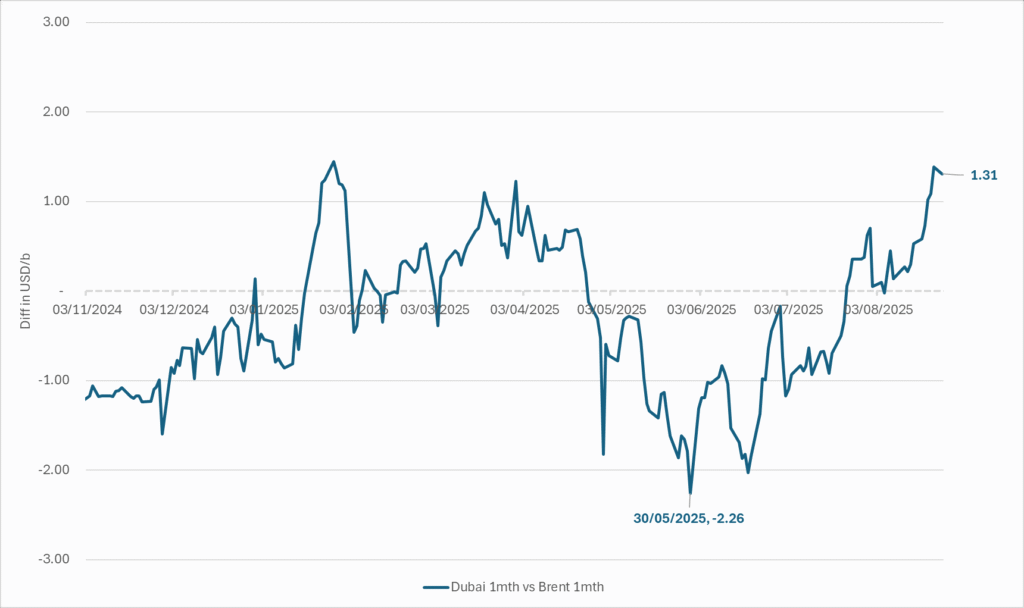
The Brent crude oil forward curve (latest in white) keeps stuck in backwardation at the front end of the curve. I.e. it is still a tight crude oil market at present. The smile-effect is the market anticipation of surplus down the road.
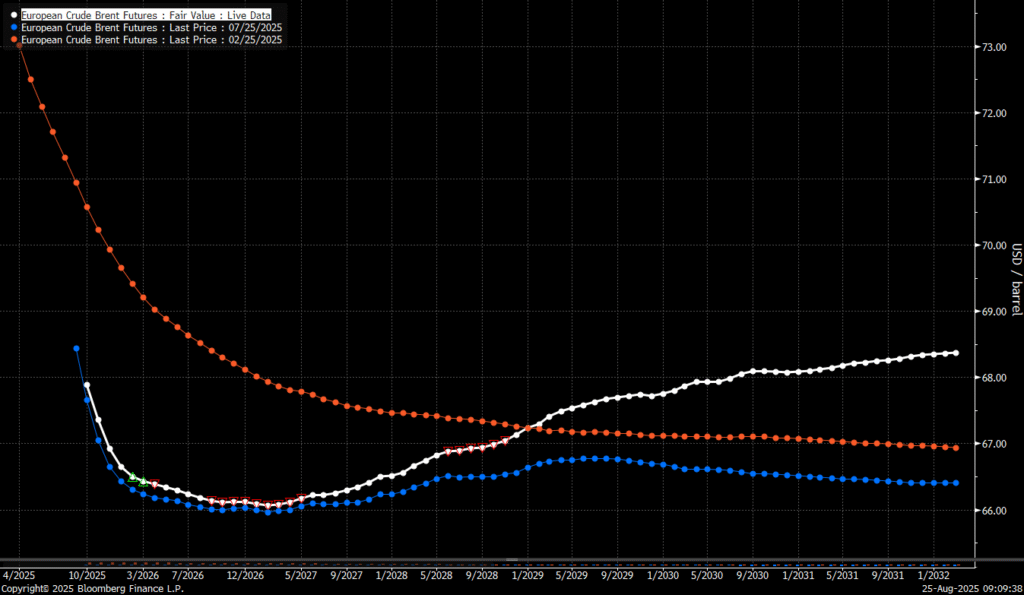
Analys
Brent edges higher as India–Russia oil trade draws U.S. ire and Powell takes the stage at Jackson Hole

Best price since early August. Brent crude gained 1.2% yesterday to settle at USD 67.67/b, the highest close since early August and the second day of gains. Prices traded to an intraday low of USD 66.74/b before closing up on the day. This morning Brent is ticking slightly higher at USD 67.76/b as the market steadies ahead of Fed Chair Jerome Powell’s Jackson Hole speech later today.

No Russia/Ukraine peace in sight and India getting heat from US over imports of Russian oil. Yesterday’s price action was driven by renewed geopolitical tension and steady underlying demand. Stalled ceasefire talks between Russia and Ukraine helped maintain a modest risk premium, while the spotlight turned to India’s continued imports of Russian crude. Trump sharply criticized New Delhi’s purchases, threatening higher tariffs and possible sanctions. His administration has already announced tariff hikes on Indian goods from 25% to 50% later this month. India has pushed back, defending its right to diversify crude sourcing and highlighting that it also buys oil from the U.S. Moscow meanwhile reaffirmed its commitment to supply India, deepening the impression that global energy flows are becoming increasingly politicized.
Holding steady this morning awaiting Powell’s address at Jackson Hall. This morning the main market focus is Powell’s address at Jackson Hole. It is set to be the key event for markets today, with traders parsing every word for signals on the Fed’s policy path. A September rate cut is still the base case but the odds have slipped from almost certainty earlier this month to around three-quarters. Sticky inflation data have tempered expectations, raising the stakes for Powell to strike the right balance between growth concerns and inflation risks. His tone will shape global risk sentiment into the weekend and will be closely watched for implications on the oil demand outlook.
For now, oil is holding steady with geopolitical frictions lending support and macro uncertainty keeping gains in check.
Oil market is starting to think and worry about next OPEC+ meeting on 7 September. While still a good two weeks to go, the next OPEC+ meeting on 7 September will be crucial for the oil market. After approving hefty production hikes in August and September, the question is now whether the group will also unwind the remaining 1.65 million bpd of voluntary cuts. Thereby completing the full phase-out of voluntary reductions well ahead of schedule. The decision will test OPEC+’s balancing act between volume-driven influence and price stability. The gathering on 7 September may give the clearest signal yet of whether the group will pause, pivot, or press ahead.
-
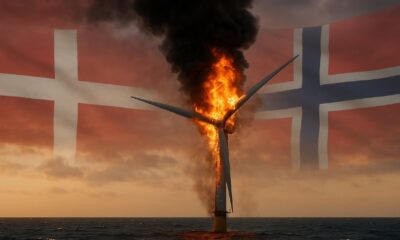
 Nyheter3 veckor sedan
Nyheter3 veckor sedanOmgående mångmiljardfiasko för Equinors satsning på Ørsted och vindkraft
-
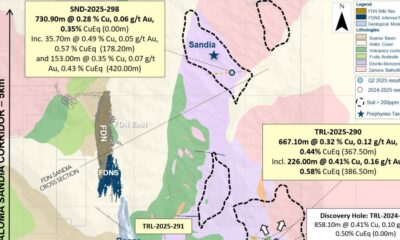
 Nyheter4 veckor sedan
Nyheter4 veckor sedanLundin Gold hittar ny koppar-guld-fyndighet vid Fruta del Norte-gruvan
-

 Nyheter1 vecka sedan
Nyheter1 vecka sedanMeta bygger ett AI-datacenter på 5 GW och 2,25 GW gaskraftverk
-

 Nyheter3 veckor sedan
Nyheter3 veckor sedanGuld stiger till över 3500 USD på osäkerhet i världen
-

 Analys3 veckor sedan
Analys3 veckor sedanWhat OPEC+ is doing, what it is saying and what we are hearing
-

 Nyheter4 veckor sedan
Nyheter4 veckor sedanAlkane Resources och Mandalay Resources har gått samman, aktör inom guld och antimon
-
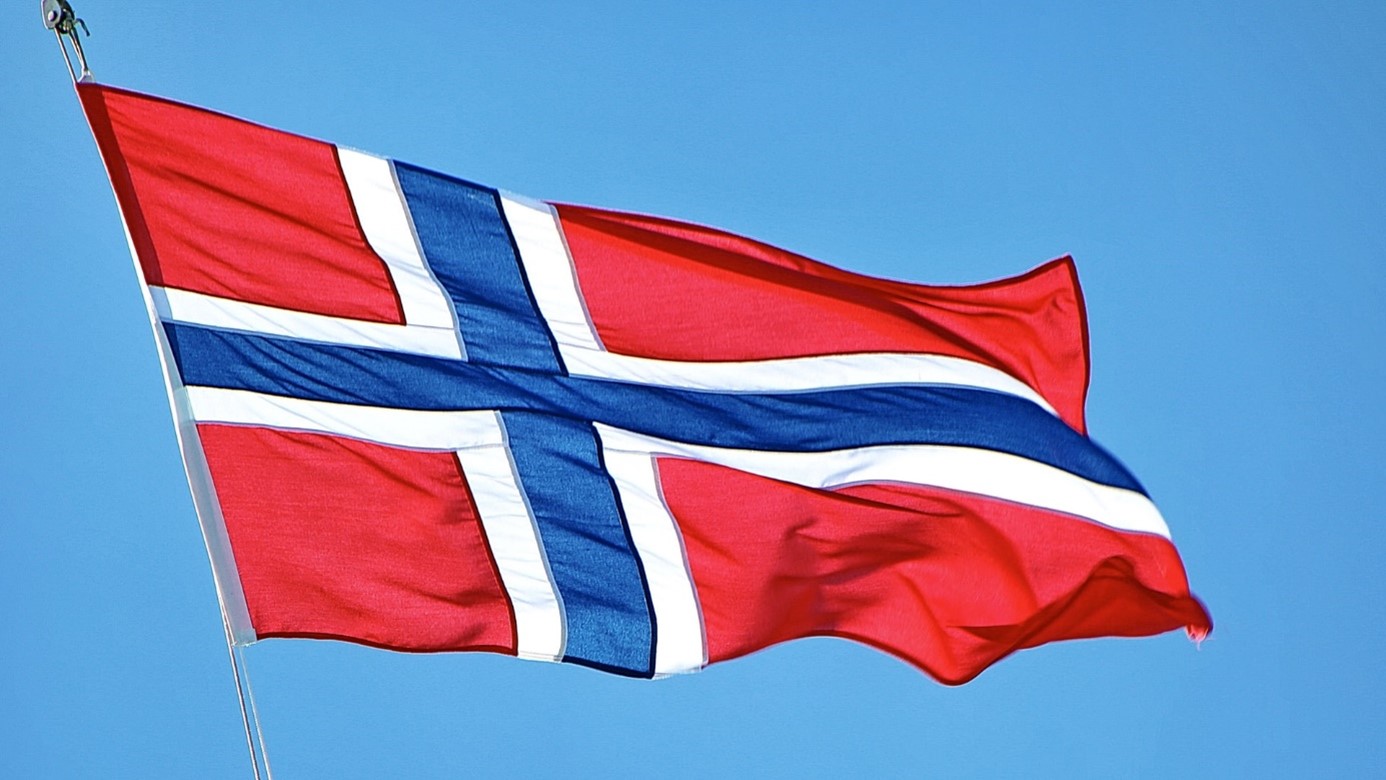
 Nyheter2 veckor sedan
Nyheter2 veckor sedanAker BP gör ett av Norges största oljefynd på ett decennium, stärker resurserna i Yggdrasilområdet
-

 Nyheter3 veckor sedan
Nyheter3 veckor sedanLyten, tillverkare av litium-svavelbatterier, tar över Northvolts tillgångar i Sverige och Tyskland


